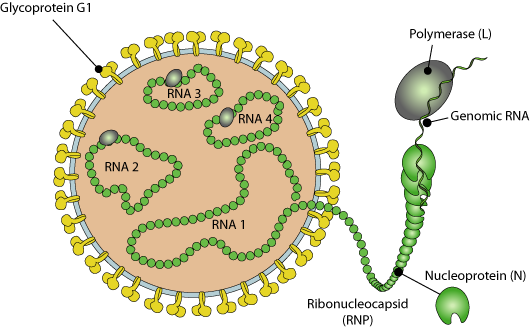VIRION

Enveloped, spherical.
GENOME
The genome is segmented and consists of four segments of linear negative-sense and single-stranded RNA. The complete genome is around 12.2 kb.
GENE EXPRESSION
The viral RNA dependent RNA polymerase (L) binds to a promoter on each encapsidated segment, and transcribes the mRNAs. These are capped by L protein during synthesis using cap snatching
ENZYMES
REPLICATION
IN PLANT:CYTOPLASMIC
- Virus penetrates into the cell by effraction or plasmodesmata transport.
- Sequential transcription.
- Replication presumably starts when enough nucleoprotein is present to encapsidate neo-synthetized antigenomes and genomes.
- The ribonucleocapsid can penetrate in neighboring plant cells through plasmodesmata transport
- Alternatively budding of particles occurs at the cell membrane, releasing new virions.
IN INSECT:CYTOPLASMIC
- Attachment of the viral G glycoproteins to host receptors.
- Fusion of virus membrane with the vesicle membrane; ribonucleocapsid is released into the cytoplasm.
- Sequential transcription.
- Replication presumably starts when enough nucleoprotein is present to encapsidate neo-synthetized antigenomes and genomes.
- Budding of particles occurs at the cell membrane, releasing new virions.

